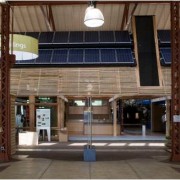In this day and age, everyone is crazy for “going green”—which is great, obviously. With all of us pulling together and changing the way we impact the environment, we can implement a positive change for good. When focusing on your daily routines for going green, your HVAC system is no exception, especially for areas with extreme inclement weather and harsh climate changes throughout the year. With my experience as a technician for Griffith Heating and Air for 23 years, I am here to help you not only gain the “eco-friendly” stamp, but also help you stay comfortable and cool in your home while doing it.
Reconsider how you regulate the temperature of your home. Most people immediately turn the temperature down to what they think is the necessary cooling they need for the house. But research shows that our comfort in an environment is equal parts mental as it is physical. In fact, many office buildings install dummy thermostats to give employees the impression that they’re adjusting the temperature – and it works, too. This is not to mention that each time you lower the temperature by one degree, it takes up 5% more energy to cool your house.
Use fans to help improve your airflow. Place them near the vents in your house, and use them as a way to spread the cool air around. This can keep your air conditioner at a lower level, and reduces the amount of energy used. For mild days, you might be able to avoid using your HVAC system altogether if you use window fans to pull in cooler air rather than constantly relying on your HVAC equipment for your climate control.
Seal gaps and cracks in your doors, windows, and floorboards to make sure that none of the energy you’re using is being wasted. Use weather-stripping on movable parts and caulk on inoperable areas to seal your home’s environment as cleanly as possible. Poor insulation, particularly in lofts or historical homes, can be a massive sink on your energy bill.
Adjust your blinds depending on the season. In the midst of winter, you can save your heater some work by letting the sun do its part on warming your environment. Likewise, closing the blinds and curtains during summer can deflect a great deal of heat generated by sunlight. The difference between a home with fully closed blinds and a home with open ones can make a substantial difference in shaping a comfortable environment.
Check the roof of your home for any causes in higher utility bills. A leaky, poorly insulated roof might be wasting a significant part of your energy cost. Another aspect to consider is if your roof is a darker color; particularly in warmer climates, this will lead to its absorbing more heat, resulting in you using your cooling system more frequently. Choose a lighter colored roof the next time your home is overdue for a roof retiling.
Change or clean the filters of your HVAC system regularly. It’s one of the easiest and most frequently overlooked aspects of maintaining a system. Depending on your environment (shedding pets, people with allergens, amount of dust in the area), you may need to perform filter maintenance between every 1-3 months. If your filter has a cardboard frame, it’s likely the replaceable variety. If not, vacuum the filter, rinse it with hot water, and allow it to air dry before returning. It’ll raise the quality of your indoor air and stop your system from having to wheeze around a thick carpet of dust to do its job – meaning better efficiency.
These are quick and simple tips to change the area of living in your home to be a more green and energy efficient space. By following these simple steps, you can see your bills lowered, and your carbon footprint several sizes smaller: a win-win for all.
Jason Wall is an HVAC technician who writes for Griffith Energy Services. When he isn’t working or writing, he can be found enjoying a good baseball game or spending time with his family.




